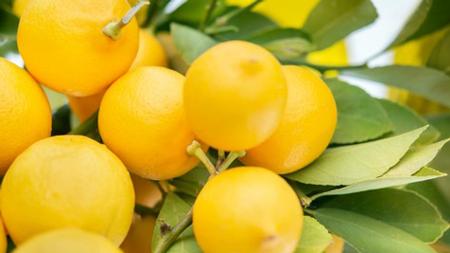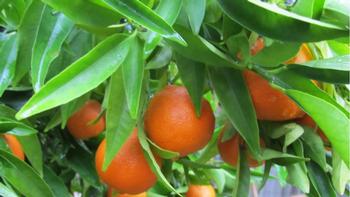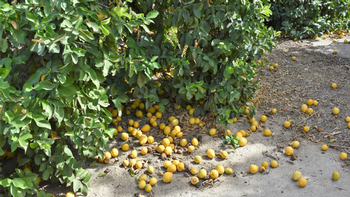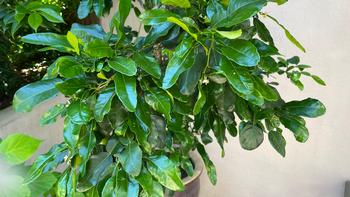Citrus: How to Grow it Juicy, Sweet and Delicious
-
One of the great joys of living in Marin is walking out to the lemon tree almost every day of the year and picking a bright yellow, aromatic, juicy, lemon. Lemons are considered everbearing, but generally produce most of their crop in winter and spring. A happy lemon tree is one sporting blossoms, immature fruit, and ripe fruit, all at the same time.
 Cristina Anne Costello, Unsplash
Cristina Anne Costello, UnsplashCitrus trees make excellent additions to the home garden. Their shiny green foliage, fragrant blossoms, and colorful, edible fruit provide year-round benefits.
Where and when to plant?
While citrus can be planted almost any time of year, it’s important to keep our current drought in mind and wait until fall -- or ideally, next spring -- to introduce any new plants to your collection. Look for a warm sunny spot in your garden or on your deck and plan for growth. Consider planting your tree near a south-facing wall for additional warmth and frost protection.
What type of soil is best?
Citrus prefer slightly acidic soil and require excellent drainage.
What about size?
A mature standard lemon tree can reach 20 feet tall, and other species up to 30 feet. Dwarf citrus will sometimes grow to 12 feet. The size can also be controlled through regular pruning.
How to water?
Watering correctly is critical to the development of good-quality fruit and allows trees to preserve a natural resistance to fungal diseases. Underwatering produces fruit that is small, and your lemons will tend to sunburn. Overwatering predisposes the tree to root and crown rots. During the heat of summer, citrus requires at least four to six inches of water per month. Depending on soil type this many be divided into several applications, irrigating about once a week. Newly planted trees should be watered twice a week. Citrus like moist but not soggy soil. Monitor soil moisture as over watering can kill a citrus tree and it can also cause the fruit to split.
What are climate considerations?
In general, citrus requires a great deal of summer heat and relatively frost-free sites. Ideal locations will provide at least six hours of full sun per day and be relatively wind free. Climate zones throughout Marin support lemons, limes, and kumquats. Favorite lemon varieties include ‘Improved Meyer Lemon’ and ‘Eureka.’ ‘Bearss' lime and ‘Nagami' kumquat are good local choices. Oranges and mandarins grow well in warmer inland areas. Favorite mandarins include ‘Satsuma’ and ‘Kishu.’ 'Pixie' is a seedless mandarin that performs well in mild coastal climates. ‘Washington Navel’ is a good orange choice for warmer Marin areas.
Do citrus need fertilizer?
Most mature citrus require regular fertilization with nitrogen, which should be applied in January or February just prior to bloom. Apply again in May and perhaps a third time in June. Dwarf plants or trees in containers with restricted root space may require less fertilizer. Select a fertilizer labeled for citrus; besides nitrogen, phosphorous, and potassium, it should contain the minor nutrients iron, manganese, and zinc. Choose an organic fertilizer and follow package directions for application rate. If the foliage turns chlorotic (indicated by yellow leaves with green veins), spray it with a foliar food containing chelated iron and the minor nutrients listed above. Withhold fertilizer from fall through midwinter. Petite 'Pixie' mandarins are small and sweet. The trees are a manageable size at 6 feet tall, and the fruit is prolific and delicious. Marie Narlock
Petite 'Pixie' mandarins are small and sweet. The trees are a manageable size at 6 feet tall, and the fruit is prolific and delicious. Marie NarlockWhat are common pests and diseases?
Citrus can become infested with mites, scale, whiteflies, and thrips. Reduce the chance of infestation by periodically hosing off the leaves. Control of ants also helps ward off pests. Pick snails off citrus in the early morning. Discourage rodents by keeping citrus limbs from touching the ground or other trees. Consider wrapping the trunk with metal guards.
Have you noticed your citrus tree leaves curling and discoloring? If you’ve ruled out too much or too little water as a culprit, you might have citrus leaf miner. This is caused by tiny nocturnal moths that tunnel in new leaf flush. Neem oil can be applied to deter the moths from laying their eggs on the leaves. Organic insecticides containing spinosad may be used as foliar spray applications to control an infestation.
A new threat to California citrus is the Asian citrus psyllid (ACP). It’s a winged insect that carries a disease called citrus greening. There is no cure, and infected plants must be destroyed. To read more about ACP, click here.
Why is my citrus fruit dropping off?
If your tree has suddenly shed a bunch of young fruit, you may be experiencing “June drop.” Young fruit (smaller than one inch in diameter) may drop in May, June, and/or July. Some fruit drop is natural. Excessive drop may be due to drought stress, sudden high temperatures, low humidity, or nitrogen deficiency. Heavy pruning, thrips, mites, or spray injury can also cause fruit to drop. Keep trees in good health and well irrigated to minimize fruit drop, although drop is not all bad as it acts as a self-regulating mechanism. Too much fruit set will cause small fruit size. Citrus fruit drop may be due to drought stress, sudden high temperatures, low humidity, or a nitrogen deficiency. Photo courtesy UC Regents
Citrus fruit drop may be due to drought stress, sudden high temperatures, low humidity, or a nitrogen deficiency. Photo courtesy UC Regents
Do citrus trees need pruning?
Young citrus trees rarely require pruning, but they may produce long shoots that give them a wild appearance. Inspect the long upright shoots that grow from the center of the tree during summer months. These are future fruit-bearing branches. If several grow from a single spot or in close proximity, remove the weakest. Keep the strongest shoots, aiming for even spacing throughout the branch structure. These shoots will, in time, bear fruit and begin bending down, possibly requiring removal of the branches beneath. Ultimately, some of these fruit-bearing branches may dip too close to the ground requiring their removal. This entire cycle from new shoot to branch removal may take five to ten years.
Sometimes branches will become so heavy with fruit that they are weighted down to the ground or even break. To help prevent this, remove branches whose tips are growing closer than 24 inches from the ground, because fruit that sags to ground level may develop fungus infections. Shorten these branches back to a scaffold branch (primary limb), or if needed, remove the offending scaffold branch from the trunk at its origin. Do not leave a stub.
Be sure to prune off any suckers that arise below the graft or bud union.
What about frost and freeze?
Citrus trees need protection when temperatures dip below 30 degrees. Water the tree well and cover with a protective blanket but remove the cover during the day. Incandescent Christmas lights (not LEDs) wrapped around the tree can also offer some warmth on colder nights. Learn more about managing frost.
Planning for the future
While we work to minimize our water usage through this challenging summer, it's a good time to evaluate the plants in your garden. Consider replacing a water-guzzling ornamental with a citrus tree that will provide year-round green foliage with the benefit of tasty fruit. Research something new that might fit well into your garden and diet. The leaves of this 20 year-old makrut add an intoxicating herbal flavor to various Asian inspired dishes. Jane Scurich
The leaves of this 20 year-old makrut add an intoxicating herbal flavor to various Asian inspired dishes. Jane ScurichSome options to consider include:
- ‘Nordmann Seedless Nagami' kumquat – trees bear large crops and are cold tolerant
- Makrut lime (also known as kaffir) -- trees are not grown primarily for their tiny fruit, but for their tender leaves, which are used in cooking.
- ‘Variegated pink-fleshed Eureka’ lemon – also known as ‘Pink Lemonade’ – rind is green and cream striped with light pink, very acid flesh.
- ‘Eustis’ lime – small trees that are more cold tolerant than regular lime trees.
What do I do with all this fruit?
The UC Master Food Preservers (MFP) offer a variety of ideas for preserving and serving your citrus bounty. Much like the UC Master Gardeners, the MFPs are trained volunteers who extend UC research-based information about home food safety and preservation to the public.
Learn more about growing citrus and other edibles.




